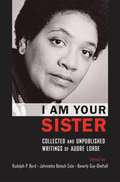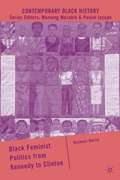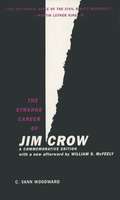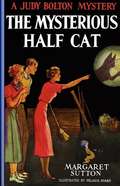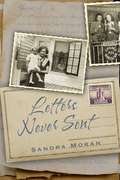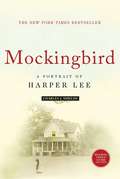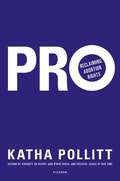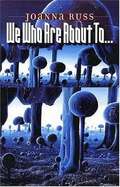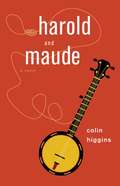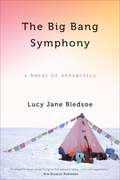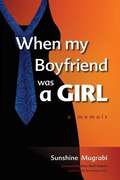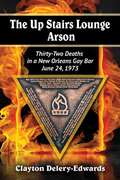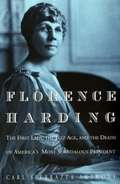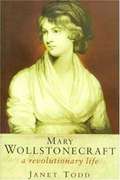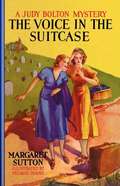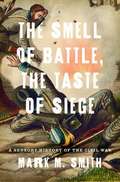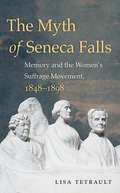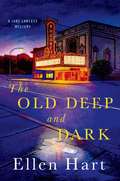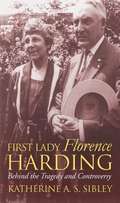- Table View
- List View
It Must be Love 'Cause I Feel So Dumb
by Arthur BarronErik is a New York kid... everything in the city belongs to him - except maybe pretty Lisa Dwyer. Erik is nearly fourteen. He's a loner, but he's not exactly alone. There's his best friend--actually his dog, Bill ... Hubert's Flea Museum on 42nd street ... his comic book collection ... his passion for graffiti. (On the wall in Riverside Park at 98th street is his magnum opus--"ERIK-'75," spray-painted six-feet high.) Still, something has disturbed Erik's equilibrium. Her name is Lisa Dwyer. She's the prettiest pom-pom girl at school. And he thinks he loves her. How can he get her to notice him? He thinks he has just the thing!
I Am Your Sister: Collected and Unpublished Writings of Audre Lorde
by Rudolph P. Byrd Johnnetta Betsch Cole Beverly Guy-SheftallAudre Lorde was not only a famous poet; she was also one of the most important radical black feminists of the past century. Her writings and speeches grappled with an impressive broad list of topics, including sexuality, race, gender, class, disease, the arts, parenting, and resistance, and they have served as a transformative and important foundation for theorists and activists in considering questions of power and social justice. Lorde embraced difference, and at each turn she emphasized the importance of using it to build shared strength among marginalized communities. I Am Your Sister is a collection of Lorde's non-fiction prose, written between 1976 and 1990, and it introduces new perspectives on the depth and range of Lorde's intellectual interests and her commitments to progressive social change. Presented here, for the first time in print, is a major body of Lorde's speeches and essays, along with the complete text of A Burst of Light and Lorde's landmark prose works Sister Outsider and The Cancer Journals. Together, these writings reveal Lorde's commitment to a radical course of thought and action, situating her works within the women's, gay and lesbian, and African American Civil Rights movements. They also place her within a continuum of black feminists, from Sojourner Truth, to Anna Julia Cooper, Amy Jacques Garvey, Lorraine Hansberry, and Patricia Hill Collins. I Am Your Sister concludes with personal reflections from Alice Walker, Gloria Joseph, Johnnetta Betsch Cole, Beverly Guy-Sheftall, and bell hooks on Lorde's political and social commitments and the indelibility of her writings for all who are committed to a more equitable society.
Sisterhood is Powerful: An Anthology of Writings from the Women’s Liberation Movement
by Robin MorganPublished in 1970, this was the first comprehensive collection of writings from the "Women's Liberation Movement" in the United States, including articles, poems, photographs, and manifestos. It is the precursor to Sisterhood Is Global: The International Women's Movement Anthology (1984), and Sisterhood Is Forever: The Women's Anthology for a New Millennium (2003)
Black Feminist Politics from Kennedy to Clinton
by Duchess HarrisTaking an interdisciplinary approach, this book analyzes Black women's involvement in American political life, focusing on what they did to gain political power between 1961 and 2001, and why, in many cases, they did not succeed.
The Strange Career of Jim Crow
by C. Vann Woodward William S. McFeely (afterword]C. Vann Woodward, who died in 1999 at the age of 91, was America's most eminent Southern historian, the winner of a Pulitzer Prize for Mary Chestnut's Civil War and a Bancroft Prize for The Origins of the New South. Now, to honor his long and truly distinguished career, Oxford is pleased to publish this special commemorative edition of Woodward's most influential work, The Strange Career of Jim Crow. The Strange Career of Jim Crow is one of the great works of Southern history. Indeed, the book actually helped shape that history. Published in 1955, a year after the Supreme Court in Brown v. Board of Education ordered schools desegregated, Strange Career was cited so often to counter arguments for segregation that Martin Luther King, Jr. called it "the historical Bible of the civil rights movement. " The book offers a clear and illuminating analysis of the history of Jim Crow laws, presenting evidence that segregation in the South dated only to the 1890s. Woodward convincingly shows that, even under slavery, the two races had not been divided as they were under the Jim Crow laws of the 1890s. In fact, during Reconstruction, there was considerable economic and political mixing of the races. The segregating of the races was a relative newcomer to the region. Hailed as one of the top 100 nonfiction works of the twentieth century, The Strange Career of Jim Crow has sold almost a million copies and remains, in the words of David Herbert Donald, "a landmark in the history of American race relations. "
The Mysterious Half Cat (Judy Bolton Mysteries #9)
by Margaret SuttonJudy is excited that her old friend, "Scottie", is returning to Farringdon. They plan a huge welcoming party for Scottie at the railroad station, but things turn for the worse when Scottie is upset and agitated, trying to control her little sister, Carol. Carol is a very difficult child and Scottie expects Judy to help her find a way to help Carol while also searching for lost relatives. Unfortunately, Judy is in the midst of two other mysteries. Strange happening at the Chinese laundry and disappearing objects have Judy in detective mode. Follow Judy as she helps solve Carol's problem and helps everyone come together. The thirty-eight volume Judy Bolton series was written during the thirty-five years from 1932-1967. It is one of the most successful and enduring girls' series ever published. The Judy Bolton books are noted not only for their fine plots and thrilling stories, but also for their realism and their social commentary. Unlike most other series characters, Judy and her friends age and mature in the series and often deal with important social issues. To many, Judy is a feminist in the best light-smart, capable, courageous, nurturing, and always unwavering in her true beliefs; a perfect role model.
Letters Never Sent
by Sandra MoranThree women, united by love and kinship, struggle to conform to the social norms of the times in which they lived. In 1931, Katherine Henderson leaves behind her small town in Kansas and the marriage proposal of a local boy to live on her own and work at the Sears & Roebuck glove counter in Chicago. There she meets Annie--a bold, outspoken feminist who challenges Katherine's idea of who she thinks she is and what she thinks she wants in life. In 1997, Katherine's daughter, Joan, travels to Lawrence, Kansas, to clean out her estranged mother's house. In an old suitcase she finds a wooden box containing trinkets and a packet of sealed letters to a person identified only by a first initial. Joan reads the unsent letters and discovers a woman completely different from the aloof and unyielding mother of her youth--a woman who had loved deeply and lost that love to circumstances beyond her control. Now Joan just has to find the strength to use the healing power of empathy and forgiveness to live the life she's always wanted to live.
Mockingbird: A Portrait of Harper Lee
by Charles J. ShieldsTo Kill a Mockingbird--the twentieth century's most widely read American novel--has sold thirty million copies and still sells a million yearly. Yet despite her book's perennial popularity, its creator, Harper Lee, has become a somewhat mysterious figure. Now, after years of research, Charles J. Shields brings to life the warmhearted, high-spirited, and occasionally hardheaded woman who gave us two of American literature's most unforgettable characters--Atticus Finch and his daughter, Scout. At the center of Shields's evocative, lively book is the story of Lee's struggle to create her famous novel, but her colorful life contains many highlights--her girlhood as a tomboy in overalls in tiny Monroeville, Alabama; the murder trial that made her beloved father's reputation and inspired her great work; her journey to Kansas as Truman Capote's ally and research assistant to help report the story ofIn Cold Blood. Mockingbird--unique, highly entertaining, filled with humor and heart--is a wide-ranging, idiosyncratic portrait of a writer, her dream, and the place and people whom she made immortal.
Pro: Reclaiming Abortion Rights
by Katha PollittA powerful argument for abortion as a moral right and social good by a noted feminist and longtime columnist for the nation. Forty years after the landmark Roe v. Wade ruling, "abortion" is still a word that is said with outright hostility by many, despite the fact that one in three American women will have terminated at least one pregnancy by menopause. Even those who support a woman's right to an abortion often qualify their support by saying abortion is a "bad thing," an "agonizing decision," making the medical procedure so remote and radioactive that it takes it out of the world of the everyday, turning an act that is normal and necessary into something shameful and secretive. Meanwhile, with each passing day, the rights upheld by the Supreme Court are being systematically eroded by state laws designed to end abortion outright. In this urgent, controversial book, Katha Pollitt reframes abortion as a common part of a woman's reproductive life, one that should be accepted as a moral right with positive social implications. In Pro, Pollitt takes on the personhood argument, reaffirms the priority of a woman's life and health, and discusses why terminating a pregnancy can be a force for good for women, families, and society. It is time, Pollitt argues, that we reclaim the lives and the rights of women and mothers.
We Who Are About To...
by Joanna Russ Samuel R. DelanyFirst published in 1976. A multi-dimensional explosion hurls the starship's few passengers across the galaxies and onto an uncharted barren tundra. With no technical skills and scant supplies, the survivors face a bleak end in an alien world. One brave woman holds the daring answer, but it is the most desperate one possible. Elegant and electric, We Who Are About To... brings us face to face with our basic assumptions about our will to live. While most of the stranded tourists decide to defy the odds and insist on colonizing the planet and creating life, the narrator decides to practice the art of dying. When she is threatened with compulsory reproduction, she defends herself with lethal force. Originally published in 1977, this is one of the most subtle, complex, and exciting science fiction novels ever written about the attempt to survive a hostile alien environment. It is characteristic of Russ's genius that such a readable novel is also one of her most intellectually intricate.
Harold and Maude
by Colin HigginsNineteen-year-old Harold Chasen is obsessed with death. He fakes suicides to shock his self-obsessed mother, drives a hearse, and attends funerals of complete strangers. Seventy-nine-year-old Maude Chardin, on the other hand, adores life. She liberates trees from city sidewalks and transplants them to the forest, paints smiles on the faces of church statues, and "borrows" cars to remind their owners that life is fleeting-- here today, gone tomorrow! A chance meeting between the two turns into a madcap, whirlwind romance, and Harold learns that life is worth living, and how to play the banjo. Harold and Maude started as Colin Higgins's master's thesis at UCLA film school before being made into the 1971 film directed by Hal Ashby. The quirky, dark comedy gained a loyal cult following, and in 1997 it was selected for inclusion on the National Film Registry at the Library of Congress. Higgins's novelization was released with the original film but has been out of print for more than thirty years. Fans who have seen the movie dozens of times will find this a valuable companion, as it gives fresh elements to watch for and answers many of the film's unresolved questions.
The Big Bang Symphony: A Novel of Antarctica
by Lucy Jane BledsoeAntarctica is a vortex that draws you back, season after season. The place is so raw and pure, all seal hide and crystalline iceberg. The fishbowl communities at McMurdo Station, South Pole Station, and in the remote field camps intensify relationships, jack all emotion up to a 10. The trick is to get what you need and then get out fast. At least that's how thirty-year-old Rosie Moore views it as she flies in for her third season on the Ice. She plans to avoid all entanglements, romantic and otherwise, and do her work as a galley cook. But when her flight crash-lands, so do all her plans. Mikala Wilbo, a brilliant young composer whose heart--and music--have been frozen since the death of her partner, is also on that flight. She has come to the Ice as an artist-in-residence, to write music, but also to secretly check out the astrophysicist father she has never met. Arriving a few weeks later, Alice Neilson, a graduate student in geology who thinks in charts and equations, is thrilled to leave her dependent mother and begin her career at last. But from the start she is aware that her post-doc advisor, with whom she will work in Antarctica, expects much more from their relationship. As the three women become increasingly involved in each other's lives, they find themselves deeply transformed by their time on the Ice. Each falls in love. Each faces challenges she never thought she would meet. And ultimately, each finds redemption in a depth and quality of friendship that only the harsh beauty of Antarctica can engender. Finalist, Lambda Literary Awards Finalist, Ferro-Grumley Award for LGBT Fiction, awarded by the Publishing Triangle Finalist, Northern California Independent Booksellers Association Honorable Mention, Foreword Magazine's Gay/Lesbian Fiction Book of the Year Best Books for General Audiences, selected by the Public Library Association
When My Boyfriend Was A Girl: A Memoir
by Sunshine MugrabiListed as a Must-Read, The Advocate calls it a "casual but highly readable memoir. " Sunshine had been unlucky in love-with both men and women-for years. She needed a new plan. What else could she do but hit the internet, cross her fingers, and hope for the best? In this heartfelt, humorous memoir the author takes readers on her personal journey of falling in love with Leor, who was born female, but who became the man of her dreams, through all of the ups and downs of loving a newly transgendered man. This riveting memoir is part love story, part Rorschach relationship test, and a psychological mirror for everyone who has ever been in love. The book gives readers an extremely rare and intimate glimpse into the lives of transgendered people and the people who love them. It also helps shatter preconceived notions about gender identity. And it should be required reading for those about to embark on a relationship, no matter their sexual orientation. When My Boyfriend Was a Girl is a mind-blowing memoir that will shatter any preconceived notions you have about gender, relationships, and love. With a foreword by Max Wolf Valerio, author of "The Testosterone Files. "
The Up Stairs Lounge Arson: Thirty-two Deaths in a New Orleans Gay Bar, June 24, 1973
by Clayton Delery-EdwardsOn June 24, 1973, a fire in a New Orleans gay bar killed 32 people. This still stands as the deadliest fire in the city's history. Though arson was suspected, and though the police identified a likely culprit, no arrest was ever made. Additionally, government and religious leaders who normally would have provided moral leadership at a time of crisis were either silent or were openly disdainful of the dead, most of whom were gay men. Based upon review of hundreds of primary and secondary sources, including contemporary news accounts, interviews with former patrons of the lounge, and the extensive documentary trail left behind by the criminal investigations, The Up Stairs Lounge Arson tells the story of who frequented this bar, what happened on the day of the fire, what course the investigations took, why an arrest was never made, and what the lasting effects of the fire have been.
Florence Harding: The First Lady, the Jazz Age and the Death of America's Most Scandalous President
by Carl Sferrazza AnthonyTells the story of Florence Harding's rise from young unwed mother to First Lady and reveals her influence behind Harding's ascent to America's most scandal-ridden presidency and her role in his death. The drama of her life is set against the stage of the White House in the Jazz Age, and involves exciting elements such as mistresses, blackmail, poisoning, and opium addicts.
A Different Face: The Life of Mary Wollstonecraft
by Emily W. SunsteinMary Wollstonecraft, author of the eighteenth-century classic, A Vindication of the Rights of Woman, is a fascinating subject for biography. She did not march through life toward specific goals of feminism, but fought her way to personal independence with a passionate, stubborn intensity at a time when women--presumed inferior--were narrowly circumscribed by law, custom and religious belief. She demanded also a ration of happiness and sexual fulfillment, refusing to conform to the model of a submissive, decorative, domestically useful woman. Possessed of great intellectual ambitions, and largely self-educated, Mary Wollstonecraft rebelled against injustice everywhere she perceived it, and gradually became a political radical. Without money or family support, she yet refused to marry for security. In 1787 she went to live in London, where she supported herself by her writing, at thirty-three composing her great work and finding herself a famous and controversial figure. In private life she had never been able to find satisfaction, however; she desperately sought affection. After two disastrous infatuations, an illegitimate child, and two attempts at suicide, she fell in love with William Godwin, finally securing the domestic tranquillity and love she yearned for, tragically dying in childbirth a few months after her marriage. The question Mary Wollstonecraft's life poses is one of great interest today: What kind of life should a woman ask for herself? Mary Wollstonecraft wanted it all--career and family, independence and attachment, intellectual achievement and love. In A Different Face the complexities and contradictions of a remarkable woman are examined as the author, drawing extensively from Mary Wollstonecraft's own writings, endows the biography with the living voice of Mary Wollstonecraft herself. Excellently researched, it is a dramatic and readable biography, consistently fair to the courageous, exasperating and vivid personality of one of England's most extraordinary women.
The Collected Letters of Mary Wollstonecraft
by Mary Wollstonecraft Janet ToddYou will smile at an observation that has just occurred to me: -- I consider those minds as the most strong and original, whose imagination acts as the stimulus to their senses, Mary Wollstonecraft wrote in a letter contemplating the role of the imagination in human relationships. Enlightenment feminist and famed author of The Vindication of the Rights of Woman, Wollstonecraft was also one of the most distinctive letter writers of the eighteenth century. This volume contains all of her known correspondence. Wollstonecraft talked and thought on paper; her letters were a large part of the drama of her life. In them she grows from an awkward child of fourteen to the woman of thirty-eight facing death in childbirth. Where the letters of "bluestocking" writers such as Elizabeth Carter and Catherine Talbot have a public quality, Wollstonecraft's letters -- whether written in haste or carefully composed, opinionated, or vulnerable -- stand out among those of other contemporary writers for their candor and lack of sentimentality. They create a palpable world, a sense of inner vitality, revealing a woman of consistent character who nonetheless struggled to reconcile disparate aspects of her life: integrity and sexual longing; the needs and duties of a woman; motherhood and intellectual life; fame and domesticity; reason and passion. Written in cramped lodgings and swaying boats, in the wilds of Scandinavia and the chill of Paris in winter, these letters record not a finished, ordered life viewed retrospectively but the dynamic process of living. Collectively, they form a remarkable work of autobiography that reveals the many dimensions of Wollstonecraft's genius.
The Voice In The Suitcase (Judy Bolton Mysteries #8)
by Margaret SuttonA picnic, a strange suitcase with voices from within, a surprise golden anniversary party and a friendship across the proverbial railroad tracks the Judy into her latest mystery. Everything begins with Judy and her friends befriending a pair of hungry hobos caring a strange suitcase making very peculiar sounds resembling words. After accidentally being left behind, Judy and Honey on a man appears to be left for dead in a ditch. Now he has the strange suitcase which continues to talk to them. After dropping them off the middle of nowhere at an isolated, you would think the mystery is behind them. However, Judy befriends two younger girls one poor, one entitled, and befriends the poor one, helping her prepare her grandparents home for a surprise golden anniversary party. Soon Judy becomes concerned, however, when it appears that an uncle may be involved in criminal activity. Come along with Judy and her friends on her next adventure! The thirty-eight volume Judy Bolton series was written during the thirty-five years from 1932-1967. It is one of the most successful and enduring girls' series ever published. The Judy Bolton books are noted not only for their fine plots and thrilling stories, but also for their realism and their social commentary. Unlike most other series characters, Judy and her friends age and mature in the series and often deal with important social issues. To many, Judy is a feminist in the best light-smart, capable, courageous, nurturing, and always unwavering in her true beliefs; a perfect role model.
The Hidden Window Mystery (Nancy Drew Mystery Stories #34)
by Carolyn KeeneA magazine article offering a la British medieval stained-glass window intrigues Nancy Drew. She asks Bess and George to join her on a search in Charlottesville, Virginia. Before the three friends leave River Heights, their adversary tries to get them to postpone the trip. But no luck. Nancy is determined to carry through her plans. While staying with her cousin and exploring a haunted mansion, Nancy must push people past their insecurities and superstitions of peacocks to solve interlaced mysteries! Picture descriptions added In the late 1950s, the first 34 books in the Nancy Drew series were revised and condensed. This is the version released before the books were revised.
The Smell of Battle, The Taste of Siege: A Sensory History of the Civil War
by Mark M. SmithHistorical accounts of major events have almost always relied upon what those who were there witnessed. Nowhere is this truer than in the nerve-shattering chaos of warfare, where sight seems to confer objective truth and acts as the basis of reconstruction. In The Smell of Battle, the Taste ofSiege, historian Mark M. Smith considers how all five senses, including sight, shaped the experience of the Civil War and thus its memory, exploring its full sensory impact on everyone from the soldiers on the field to the civilians waiting at home. From the eardrum-shattering barrage of shells announcing the outbreak of war at Fort Sumter; to the stench produced by the corpses lying in the mid-summer sun at Gettysburg; to the siege of Vicksburg, once a center of Southern culinary aesthetics and starved into submission, Smith recreates howCivil War was felt and lived. Relying on first-hand accounts, Smith focuses on specific senses, one for each event, offering a wholly new perspective. At Bull Run, the similarities between the colors of the Union and Confederate uniforms created concern over what later would be called "friendlyfire" and helped decide the outcome of the first major battle, simply because no one was quite sure they could believe their eyes. He evokes what it might have felt like to be in the HL Hunley submarine, in which eight men worked cheek by jowl in near-total darkness in a space 48 inches high, 42inches wide. Often argued to be the first "total war," the Civil War overwhelmed the senses because of its unprecedented nature and scope, rendering sight less reliable and, Smith shows, forcefully engaging the nonvisual senses. Sherman's March was little less than a full-blown assault on Southernsense and sensibility, leaving nothing untouched an no one unaffected. Unique, compelling, and fascinating, The Smell of Battle, The Taste of Siege, offers readers way to experience the Civil War with fresh eyes.
The Myth Of Seneca Falls: Memory And The Women's Suffrage Movement, 1848-1898
by Lisa TetraultThe story of how the women's rights movement began at the Seneca Falls convention of 1848 is a cherished American myth. The standard account credits founders such as Elizabeth Cady Stanton, Susan B. Anthony, and Lucretia Mott with defining and then leading the campaign for women's suffrage. In her provocative new history, Lisa Tetrault demonstrates that Stanton, Anthony, and their peers gradually created and popularized this origins story during the second half of the nineteenth century in response to internal movement dynamics as well as the racial politics of memory after the Civil War. The founding mythology that coalesced in their speeches and writings--most notably Stanton and Anthony's History of Woman Suffrage--provided younger activists with the vital resource of a usable past for the ongoing struggle, and it helped consolidate Stanton and Anthony's leadership against challenges from the grassroots and rival suffragists. As Tetrault shows, while this mythology has narrowed our understanding of the early efforts to champion women's rights, the myth of Seneca Falls itself became an influential factor in the suffrage movement. And along the way, its authors amassed the first archive of feminism and literally invented the modern discipline of women's history.
The Old Deep and Dark (Jane Lawless Mysteries #22)
by Ellen HartRenowned theater director Cordelia Thorn is working to restore a historic theater in downtown Minneapolis that she and her actress sister, Octavia, recently bought. Cordelia has a vision for the playhouse's future, but the more she learns about the building, the more fascinated she becomes by its past. Nicknamed "The Old Deep and Dark" because of the Prohibition-era double murder that occurred in the basement--then a speakeasy--there are a wealth of secrets hidden inside its walls. And, to her shock and horror, Cordelia discovers that there is also one present-day body literally buried in a basement wall. Cordelia immediately calls on her best friend, P. I. Jane Lawless. Although Jane is already in the thick of another investigation--she's embroiled in a well-known country-western singer's family scandal--she agrees to help Cordelia out on the side. But show-biz is a small world, and as Jane starts tracing the trails of two separate investigations, she's surprised to find they might not be as unconnected as she thought. With The Old Deep and Dark, the latest installment in the award-winning Jane Lawless series, Ellen Hart has crafted another impeccably plotted, seamlessly written mystery.
First Lady Florence Harding: Behind the Tragedy and Controversy
by Katherine A. S. SibleyFlorence Kling Harding has come down through history as one of our most scorned first ladies. Victimized by caricatures and branded a shrew, she stands at the bottom of historians' polls, her reputation tarnished by her husband's scandals despite their joint popularity while in office. These depictions, argues Katherine Sibley, have prevented us today from seeing how innovative a first lady Florence Harding really was. This new look at Mrs. Harding restores humanity to an oft-maligned figure by examining her progressive causes, her celebrity, and her role in her husband's work. For if Eleanor Roosevelt is credited with shattering the first lady's ceremonial mold, it was Florence Harding who made the first cracks. Sibley's is the first book to offer a full treatment of Florence as first lady rather than as mere supporting actress in the Harding administration. Never shying from publicity, she made herself more available to the press than did her predecessors and opened the White House up to the public. And she took such a pioneering role in Warren Harding's campaign and presidency that many thought she outdid her husband as a politician. Turning to primary sources that others have overlooked, Sibley challenges the clichés about Florence's time in the national spotlight. She describes how Mrs. Harding supported racial equality, lobbied for better treatment for veterans and female prisoners, and maintained a lifelong interest in preventing animal cruelty. As adviser to her husband, she assisted with his speechwriting and consulted with the cabinet; she was also the first first lady to deliver spontaneous speeches while traveling with the president. At a personal level, Sibley examines in detail how Mrs. Harding responded to her husband's death, assessing why this tragedy struck Americans with such force even as national empathy proved so fleeting. She also offers a more nuanced description of the president's philandering, viewing Nan Britton's claims with skepticism while noting the effects on Florence of his dalliance with Carrie Phillips. Florence Harding bequeathed an activist legacy, and it is due to her example that aspiring presidential wives are expected to campaign with their husbands and be accessible to public and press. Florence Harding truly set the stage for those to follow; this book delivers the full and fair portrait that has long been her due.
Sex Variant Women In Literature
by Jeannette Howard FosterFirst published in 1956. Essential history of lesbian literature. "Must" reading for the serious collector and researcher.
Louise Brooks
by Barry ParisLouise Brooks left Wichita, Kansas, for New York City at age fifteen and lived the kind of life of which legends are made. From her beginnings as a dancer to her years in Hollywood, Berlin, and beyond, she was hailed and reviled as a new type of woman: independent, intellectually daring, and sexually free. In this widely acclaimed, first and only comprehensive biography, Barry Paris traces Brooks's trajectory from her childhood through her fall into obscurity and subsequent "resurrection" as a brilliant writer and enduring film icon.

